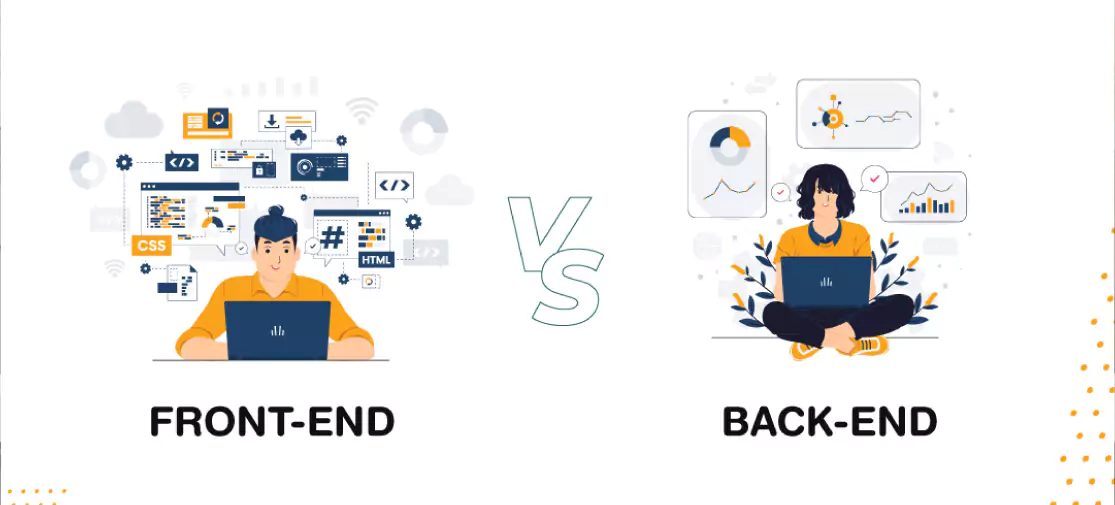My Name is Fatima Babar..
Front end and Back end languages for web
Welcome to my blog! Today, we're going to talk about front-end and back-end development, sharing important languages to help you understand front end and back end web development better.
Sunday, October 13, 2024
Saturday, October 12, 2024
Front End and Back End Languages
ABOUT FRONT END DEVELOPMENT..
Front-end development is the practice of creating the user-facing part of websites and web applications. It focuses on what users see and interact with, including the design, layout, and functionality. It’s everything you see and use when visiting a website.like..pictures,videos,buttons...
Front-end developers use languages like HTML for structure, CSS for styling, and JavaScript for interactivity to ensure that websites are responsive, and user-friendly.
Front-end developers ensure websites look good and work well on all browsers, load quickly, and provide a smooth, user-friendly experience.
1. HTML (HyperText Markup Language)
The foundational language used to structure web content.
2. CSS (Cascading Style Sheets)
Styles the appearance of HTML elements, including layout, colors, and fonts.
3. JavaScript
Adds interactivity and dynamic behavior to web pages, like animations, form validation, and event handling.
4.TypeScript
TypeScript is an enhanced version of JavaScript that allows developers to specify types for variables and functions. This helps identify errors before running the code, making it easier to build and maintain complex applications.
5.Elm
Elm is a functional programming language for creating web front-end applications. It compiles to JavaScript and focuses on simplicity and reliability.
6.Swift
Swift is a programming language used mainly for iOS and macOS development, but it can also be used for front-end web development with frameworks like SwiftUI. It offers modern features and safety for building responsive applications.
7. Sass (Syntactically Awesome Stylesheets)
A CSS preprocessor that extends CSS with features like variables, nesting, and functions.
8. Less
Another CSS preprocessor that makes CSS more maintainable with similar features as Sass.
9. JSX (JavaScript XML)
Used in React to write HTML elements within JavaScript code.
10. CoffeeScript:
A language that compiles into JavaScript, offering a simpler syntax.
11. Dart
Developed by Google, used mainly with the Flutter framework for web and mobile apps.
Haml (HTML Abstraction Markup Language): A cleaner way to write HTML by removing unnecessary syntax.
12. Stylus
Another CSS preprocessor that allows more flexible and concise syntax.
13. Pug (formerly Jade)
A template engine for generating HTML, making it more readable and concise.
List of front-end technologies
CSS Frameworks
Bootstrap: Helps make responsive (mobile-friendly) websites.
Tailwind CSS: Helps style websites quickly with utility classes.
JavaScript Frameworks/Libraries
React: Makes building user interfaces easier.
Vue.js: A flexible framework for building web apps.
Angular: A full-featured framework for larger apps.
Package Managers
npm: Helps install JavaScript libraries.
Yarn: Another tool for managing JavaScript packages.
Build Tools
Webpack: Bundles your code into one file for faster websites.
Gulp: Automates tasks like minifying files.
Responsive Design
Flexbox: A CSS layout tool for flexible designs.
CSS Grid: Helps create grid layouts easily.
Testing Tools
Jest: Tests if your JavaScript code works correctly.
Cypress: Tests your website in real-time.
UI Component Libraries
Material-UI: Pre-designed components for React apps.
Chakra UI: Simple, customizable React components.
Static Site Generators
Next.js: Helps build fast websites using React, with static pages.
Gatsby: Uses React to create super-fast static websites.
Jekyll: Generates simple static sites (commonly used with GitHub Pages).
Web APIs
Fetch API: Lets JavaScript retrieve data from a server (e.g., for loading new content).
WebSockets: Enables real-time communication (e.g., for chat apps).
Service Workers: Helps make websites work offline by caching files.
Version Control
Git: Tracks changes in code and allows collaboration.
GitHub/GitLab: Platforms to store and share your code online with version control.
Performance Tools
Lazy Loading: Loads images or content only when needed to speed up websites.
Lighthouse: A tool from Google that checks your site’s performance (speed, accessibility, etc.).
CDNs (Content Delivery Networks): Speed up your site by delivering content from servers closer to the user (e.g., Cloudflare).
Progressive Web Apps (PWA)
Service Workers: Powers offline capabilities and background syncs in PWAs.
Web App Manifest: Makes your website installable like a mobile app.
Task Runners
Gulp: Automates front-end tasks like minifying CSS and JavaScript.
Grunt: Similar to Gulp, helps automate repetitive tasks.
JavaScript Testing Frameworks
Mocha: Another testing tool that helps check if your JavaScript works as expected.
Chai: Works with Mocha to provide easy-to-read test syntax.
Preprocessors
Sass: Enhances CSS with features like variables and nested rules.
Less: Similar to Sass, helps write cleaner CSS.
Browser Developer Tools
Chrome DevTools: Built into Chrome, it helps debug JavaScript, analyze performance, and inspect CSS.
Firefox Developer Tools: Similar to Chrome DevTools, for inspecting and improving your code.
Animation Libraries
GSAP (GreenSock Animation Platform): Helps create animations with JavaScript.
Anime.js: A lightweight library for creating smooth, complex animations.
Font Libraries
Google Fonts: Free web fonts you can easily add to websites.
Font Awesome: Provides icons (e.g., social media, arrows) that you can use in your site design.
Frameworks for Mobile-First Design
Foundation: Another responsive front-end framework like Bootstrap.
Bulma: A lightweight CSS framework for mobile-first designs.
These tools and technologies make building, styling, testing, and improving websites easier and more efficient.
ABOUT BACK END DEVELOPMENT..
Back-end development is the server-side part of web development that deals with everything users don’t see. It involves managing databases, servers, and application logic to process data and handle requests.
Back-end developers use programming languages like Python, Java, Ruby, PHP, and Node.js, along with various frameworks to create secure and efficient applications.
The back end makes sure the front-end can work properly by communicating through APIs and managing data effectively.
Back End Development languages..
1.JavaScript (Node.js)
JavaScript, used as a back-end language with Node.js, allows developers to run JavaScript on the server. It enables the creation of web applications that handle requests, manage databases, and serve dynamic content, all using the same language as the front end.
2.Python
5. PHP:
Back End Technologies
Frameworks
Express.js: Minimalist Node.js web application framework.
Django: High-level Python web framework that encourages rapid development.
Flask: Lightweight Python web framework for building small applications.
Ruby on Rails: Full-stack web framework for Ruby emphasizing convention.
Laravel: PHP framework known for its elegant syntax and features.
Spring Boot: Java framework for building production-ready applications quickly.
ASP.NET: Framework for building web apps with C# and VB.NET.
Gin: Fast web framework for Go, ideal for building APIs.
Phoenix: Web framework for Elixir designed for high performance.
Koa.js: Lightweight Node.js framework created by the team behind Express.js.
Databases
MySQL: Widely used open-source relational database management system.
PostgreSQL: Advanced open-source object-relational database system.
SQLite: Self-contained, file-based SQL database for small projects.
Microsoft SQL Server: Relational database management system from Microsoft.
MongoDB: NoSQL database that stores data in flexible, JSON-like documents.
Cassandra: Highly scalable NoSQL database designed for large amounts of data.
Redis: In-memory data structure store used for caching and real-time analytics.
Couchbase: NoSQL database for document-oriented storage with high performance. DynamoDB: Fully managed NoSQL database service from AWS.
Firebase Realtime Database: NoSQL cloud database for mobile and web applications.
APIs & Web Services
REST: Architectural style for designing networked applications using HTTP.
GraphQL: Query language for APIs allowing clients to request specific data.
gRPC: High-performance RPC framework developed by Google.
SOAP: Protocol for exchanging structured information in web services.
Server Technologies
Apache HTTP Server: Popular open-source web server software.
Nginx: High-performance web server and reverse proxy server.
Microsoft IIS: Internet Information Services, a web server for Windows.
Caddy: Web server with automatic HTTPS by default.
Cloud Platforms
AWS: Comprehensive cloud computing platform offering various services.
Google Cloud Platform (GCP): Suite of cloud computing services from Google.
Microsoft Azure: Cloud platform for building, testing, and deploying applications.
Heroku: PaaS for deploying and managing applications in the cloud.
DigitalOcean: Cloud infrastructure provider focused on simplicity and performance.
Authentication & Authorization
OAuth: Open standard for access delegation commonly used for token-based authentication.
JWT (JSON Web Tokens): Compact means of representing claims between parties.
OpenID Connect: Authentication layer built on top of OAuth 2.0.
LDAP: Protocol for accessing and maintaining distributed directory information.
Caching Technologies
Redis: In-memory data structure store for caching and real-time analytics.
Memcached: Distributed memory caching system for speeding up web applications.
Varnish: Web application accelerator for caching HTTP requests.
DevOps Tools
Jenkins: Open-source automation server for continuous integration and delivery.
GitLab CI/CD: Integrated CI/CD tools within GitLab for automation.
CircleCI: Cloud-based CI/CD tool for testing and deploying applications.
Travis CI: CI service used to build and test software projects on GitHub.
Terraform: Infrastructure as code tool for building and managing infrastructure.
Ansible: Open-source automation tool for configuration management.
Message Brokers
RabbitMQ: Message broker facilitating communication between applications.
Apache Kafka: Distributed event streaming platform for high-throughput data pipelines.
ActiveMQ: Open-source message broker for sending messages between clients and servers.
Monitoring & Logging
Prometheus: Open-source monitoring and alerting toolkit.
Grafana: Visualization tool for monitoring metrics from various data sources.
New Relic: Cloud-based observability platform for monitoring applications.
ELK Stack: Collection of Elasticsearch, Logstash, and Kibana for log analysis.
Microservices Architecture
Spring Cloud: Tools for building microservices with Spring Boot.
Service Mesh: Infrastructure layer for managing service-to-service communications.
File Storage Solutions
Amazon S3: Scalable object storage service for data storage and retrieval.
Google Cloud Storage: Unified object storage solution for developers and enterprises.
Azure Blob Storage: Service for storing large amounts of unstructured data in the cloud.
Other Technologies
Apache Hadoop: Framework for processing large data sets across distributed computing.
Apache Spark: Unified analytics engine for large-scale data processing.
FaaS (Function as a Service): Serverless architecture for executing functions in the cloud.
Twilio: Cloud communications platform for SMS, voice, and video.
Stripe: Payment processing platform for online transactions.
Auth0: Authentication and authorization platform as a service.
Kubernetes Operators: Extensions for managing complex stateful applications on Kubernetes.
OpenAPI (formerly Swagger): Specification for building APIs that describes their structure.
- HTML
- CSS
- Java script
- React
- AngularJS
- vue.js
- Jquery
- swift
- Typrscript
- Elm
- Bootstrap
- Sass(syntacially awsome style sheet)
- python
- C++
- Java
- C#
- Javascript
- Go(Golang)
- Rust
- Ruby
- perl
- Kotlin
- Elixir
Top FRONT END Technologies
- HTML (Hypertext Markup Language)
- CSS (Cascading Style Sheet
- JavaScript
- React.js
- Angular
- Vue.js
- TypeScript
- Sass (Syntactically Awesome Style Sheets)
- Bootstrap
- Tailwind CSS
- Webpack
- Next.js
- Figma
- Jest
- Git and GitHub
- Alpine.js
- parcel
- Material-UI
- Laravel
- Node.js (JavaScript)
- Express.js
- Python
- Django (Python)
- Flask (Python)
- Ruby on Rails (Ruby)
- Spring Boot (Java
- Laravel (PHP)
- .NET Core (C#)
- Go (Golang)
- Kotlin
- PostgreSQL
- MongoDB
- GraphQL
- Redis
- Apache Kafka
- Docker
- Kubernetes
- Nginx
- AWS Lambda (Serverless)
- Elasticsearch
About me
My Name is Fatima Babar..
-
ABOUT FRONT END DEVELOPMENT.. Front-end development is the practice...
-
My Name is Fatima Babar..






